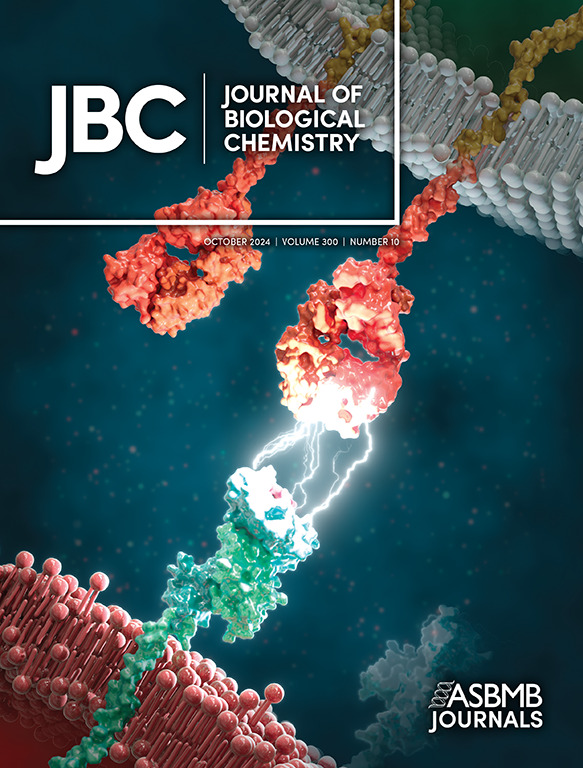Molecular basis for Gβγ-SNARE mediated inhibition of synaptic vesicle fusion.
IF 4
2区 生物学
Q2 BIOCHEMISTRY & MOLECULAR BIOLOGY
引用次数: 0
Abstract
Neurotransmitter release is a complex process involving tightly controlled co-factors and protein-protein interactions. G protein coupled receptors negatively regulate exocytosis via the interaction of G-protein βγ (Gβγ) heterodimers with soluble N-ethylmaleimide-sensitive factor attachment protein receptor (SNARE) complex. The neuronal ternary SNARE complex comprises synaptosomal-associated protein-25 (SNAP25), syntaxin-1A, and synaptobrevin-2. The regions of the SNARE complex that are important for interactions with Gβγ have been extensively characterized, but the critical sites on Gβγ are not well understood. Furthermore, the molecular basis for the specificity of different Gβ and Gγ isoforms for SNARE proteins remains elusive. Thus, we holistically probed the entire family of human Gβ and Gγ isoforms for regions critical for the target-SNARE (tSNARE) interaction using a peptide screening approach. Gβ and γ peptides with high affinities for tSNARE were then subjected to alanine scanning mutagenesis to identify the interaction sites. We found that the N-terminal coiled-coil domain of Gβγ as well as the β-propeller domain of Gβ are hotspots for SNARE interactions. Additionally, we found that the N-terminal Gγ2 peptide is a potent inhibitor of interactions between full-length Gβ1γ2 and SNAP25. We discovered that Gβ1γ2 preferentially interacts with ternary SNARE in the pre-fusion, partially zipped conformation, likely due to increased exposure of the C-terminus of SNAP25. Our combined results suggest that specific Gβγ heterodimers bind to ternary SNARE in the docked and primed state via critical residues of the β-propeller and N-terminal coil-coil domains. We propose that Gβγ binding disrupts zippering up the SNARE complex and thereby vesicle fusion.Gβγ-SNARE介导的突触囊泡融合抑制的分子基础。
神经递质释放是一个复杂的过程,涉及严格控制的辅助因子和蛋白质-蛋白质相互作用。G蛋白偶联受体通过G蛋白βγ (Gβγ)异源二聚体与可溶性n -乙基马来酰亚胺敏感因子附着蛋白受体(SNARE)复合物的相互作用负性调节胞外分泌。神经元三元SNARE复合体包括突触体相关蛋白-25 (SNAP25)、syntaxin-1A和synaptobrein -2。SNARE复合体中与Gβγ相互作用重要的区域已被广泛表征,但Gβγ上的关键位点尚不清楚。此外,不同的Gβ和Gγ亚型对SNARE蛋白特异性的分子基础仍然难以捉摸。因此,我们使用肽筛选方法全面探索了整个人类Gβ和Gγ同工型家族中靶- snare (tSNARE)相互作用的关键区域。对tSNARE具有高亲和力的Gβ和γ肽进行丙氨酸扫描诱变以确定相互作用位点。我们发现Gβγ的n端螺旋结构域和Gβ的β-螺旋桨结构域是SNARE相互作用的热点。此外,我们发现n端g - γ - 2肽是全长g - β1 - γ - 2与SNAP25相互作用的有效抑制剂。我们发现Gβ1γ2在融合前优先与三元SNARE相互作用,部分压缩构象,可能是由于SNAP25的c端暴露增加。我们的综合结果表明,特定的Gβγ异二聚体通过β-螺旋桨和n端线圈结构域的关键残基在停靠和启动状态下与三元SNARE结合。我们提出,Gβγ结合破坏了SNARE复合物的拉链,从而破坏了囊泡融合。
本文章由计算机程序翻译,如有差异,请以英文原文为准。
求助全文
约1分钟内获得全文
求助全文
来源期刊

Journal of Biological Chemistry
Biochemistry, Genetics and Molecular Biology-Biochemistry
自引率
4.20%
发文量
1233
期刊介绍:
The Journal of Biological Chemistry welcomes high-quality science that seeks to elucidate the molecular and cellular basis of biological processes. Papers published in JBC can therefore fall under the umbrellas of not only biological chemistry, chemical biology, or biochemistry, but also allied disciplines such as biophysics, systems biology, RNA biology, immunology, microbiology, neurobiology, epigenetics, computational biology, ’omics, and many more. The outcome of our focus on papers that contribute novel and important mechanistic insights, rather than on a particular topic area, is that JBC is truly a melting pot for scientists across disciplines. In addition, JBC welcomes papers that describe methods that will help scientists push their biochemical inquiries forward and resources that will be of use to the research community.
 求助内容:
求助内容: 应助结果提醒方式:
应助结果提醒方式:


